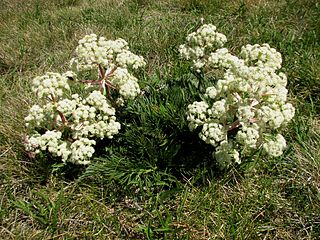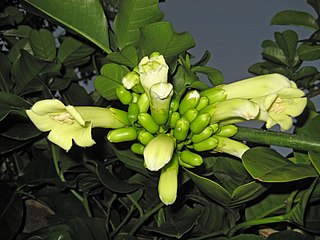
Aristotelia serrata, commonly known as wineberry or in the Māori language makomako or just mako, is a small tree in the family Elaeocarpaceae, in the genus Aristotelia, found in the North Island, South Island and Stewart Island of New Zealand. It is a small deciduous fast-growing tree or shrub. The tree can reach up to 10m tall, with a trunk diameter up to 30 cm. The bark is pale brown, smooth and patterned with flat lenticels. Branches are long, slender and spreading, branchlets have a reddish-brown colour when pubescent.

Aciphylla is a genus of about 40 species of herbaceous plants in the family Apiaceae, all but two of them endemic to New Zealand. They range from small cushion plants to tall flower spikes surrounded by rosettes of stiff, pointed leaves, the latter probably adaptations to prevent browsing by moa. Their common name is speargrass or Spaniard. Most Aciphylla species live in subalpine or alpine habitats in the South Island. Fragrant oil extracted from some large species, known as taramea, is still used as a perfume by Māori.

Tecomanthe speciosa is a species of subtropical forest lianes. A single specimen was first discovered on Manawatāwhi / Three Kings Islands, 55 km (34 mi) off the northern tip of New Zealand, during a scientific survey in 1945. No other specimens have ever been found in the wild. Tecomanthe is a tropical genus not otherwise represented in New Zealand. Four other species of Tecomanthe occur in Queensland, Indonesia, New Guinea, and the Solomon Islands.

Olearia hectorii is a species of flowering plant in the daisy family Asteraceae. Its common names include deciduous tree daisy and Hector's tree daisy. It is endemic to New Zealand, where it is nationally endangered.

Melicytus is a genus of flowering plants in the family Violaceae. Hymenanthera is a synonym. It includes 19 species native to Australia, New Zealand, and the southwestern Pacific.

Aciphylla congesta is a species of Aciphylla. It is endemic to New Zealand.

Haloragis erecta, the shrubby haloragis, toatoa or erect seaberry, is a plant species that is endemic to New Zealand.

Elaeocarpus dentatus, commonly known as hinau, is a native lowland forest tree of New Zealand. Other names in Māori for the tree are hangehange, pōkākā, and whīnau.

Olearia colensoi, commonly known as tūpare or leatherwood, is a sub-alpine shrub that is endemic to New Zealand. Other names it is known by in Māori are kūmarahou and kūmararaunui.

Pentachondra pumila, also known as carpet heath, is a small alpine shrub in the epacris family (Ericaceae). It is commonly found in Australia and New Zealand in areas of high rainfall, being known for its small white flowers as well as its red, hollow fruit that grows on branch ends. It is distinguishable as a prostrate, mat-like shrub, growing in rocky or boggy alpine areas. The fruit is edible and is a food source for many species of bird.

Myrsine salicina, synonym Rapanea salicina, commonly known as toro, is a species of shrub or small tree native to New Zealand.

Aciphylla aurea, known as taramea in Māori and golden speargrass or golden Spaniard in New Zealand English, is a large, spiky, tufted plant with sharp yellowish-green leaves in the speargrass genus Aciphylla. A. aurea is found throughout the South Island of New Zealand in montane to low alpine habitats.

Ichneutica nullifera is a moth of the family Noctuidae. This species is endemic to New Zealand and can be found in the Tongariro National Park, along the Wellington coast and throughout the South Island. The adults are large and the forewing of adults can vary in colour from pale fawn to dark grey. The larvae are coloured a bright yellow-brown with a paler underside. The larval host species are in the genus Aciphylla and as a result the adult moths are often found in habitat dominated by species in this genus. Adults are on the wing from November to early April and are sometimes attracted to light.

Hypericum japonicum, known as matted St. John's-wort, is an annual herbaceous flowering plant in the St. John's wort family Hypericaceae, in Hypericum sect. Trigynobrathys.

Carex albula, common name white sedge, is a species of sedge. It is endemic to the South Island of New Zealand.

Carex talbotii, common name Berggren's sedge, is a species of sedge in the family Cyperaceae. It is endemic to New Zealand, being found on both the North and the South Islands.

Myosotis capitata is a species of flowering plant in the family Boraginaceae, endemic to the Campbell and Auckland Islands of New Zealand. Joseph Dalton Hooker described the species in his 19th century work Flora Antarctica. Plants of this species of forget-me-not are perennial and erect, and have ebracteate inflorescences and blue corollas. It is one of two native species of Myosotis in the New Zealand subantarctic islands, the other being M. antarctica, which can also have blue corollas.

Argemone ochroleuca is a species of prickly poppy, a flowering plant commonly known as pale Mexican prickly poppy or Mexican poppy. It is native to Mexico and is also an introduced weed in many temperate and tropical regions of the world. It can grow up to 1 m in height and has a sticky yellow sap.

Convolvulus verecundus, commonly known as trailing bindweed or tussock bindweed, is a species of low-growing flowering plant in the family Convolvulaceae. Endemic to New Zealand, it was formally described as a new species by botanist Harry Allan in his 1961 work Flora of New Zealand. The type was collected near Lake Tekapo in the gorge of the Cass River, at an elevation of 850 m (2,790 ft).



















